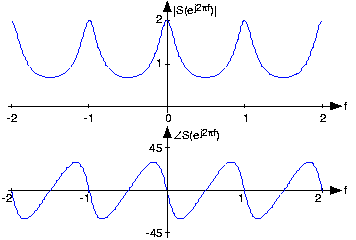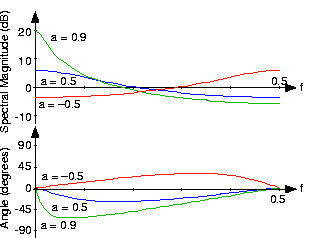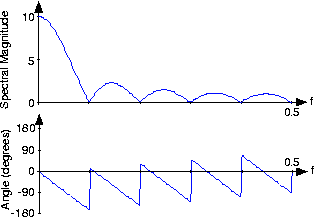| << Chapter < Page | Chapter >> Page > |
The Fourier transform of the discrete-time signal is defined to be
A special property of the discrete-time Fourier transform isthat it is periodic with period one: . Derive this property from the definition of the DTFT.
Because of this periodicity, we need only plot the spectrum overone period to understand completely the spectrum's structure; typically, we plot the spectrum over the frequency range . When the signal is real-valued, we can further simplify ourplotting chores by showing the spectrum only over ; the spectrum at negative frequencies can be derived frompositive-frequency spectral values.
When we obtain the discrete-time signal via sampling an analog signal, the Nyquist frequency corresponds to the discrete-time frequency . To show this, note that a sinusoid having a frequency equal to the Nyquist frequency has a sampled waveform that equals The exponential in the DTFT at frequency equals , meaning that discrete-time frequency equals analog frequency multiplied by the sampling interval
Let's compute the discrete-time Fourier transform of the exponentially decaying sequence , where is the unit-step sequence. Simply plugging the signal'sexpression into the Fourier transform formula,
This sum is a special case of the geometric series .
Thus, as long as , we have our Fourier transform.
Using Euler's relation, we can express the magnitude and phase of this spectrum.
No matter what value of we choose, the above formulae clearly demonstrate the periodicnature of the spectra of discrete-time signals. [link] shows indeed that the spectrum is a periodic function. We need only consider the spectrumbetween and to unambiguously define it. When , we have a lowpass spectrum—the spectrum diminishes asfrequency increases from 0 to —with increasing leading to a greater low frequency content; for , we have a highpass spectrum( [link] ).


Analogous to the analog pulse signal, let's find the spectrum of the length- pulse sequence.
The Fourier transform of this sequence has the form of a truncated geometric series.
For the so-called finite geometric series, we know that
Derive this formula for the finite geometric series sum. The "trick" is to consider the difference between theseries' sum and the sum of the series multiplied by .
which, after manipulation, yields the geometric sum formula.
Applying this result yields ( [link] .)

The inverse discrete-time Fourier transform is easily derived from the following relationship:
The properties of the discrete-time Fourier transform mirror those of the analog Fourier transform. The DTFT properties table shows similarities and differences. One important common property is Parseval's Theorem.
Suppose we obtained our discrete-time signal from values ofthe product , where the duration of the component pulses in is . How is the discrete-time signal energy related to the total energycontained in ? Assume the signal is bandlimited and that the sampling ratewas chosen appropriate to the Sampling Theorem's conditions.
If the sampling frequency exceeds the Nyquist frequency, thespectrum of the samples equals the analog spectrum, but overthe normalized analog frequency . Thus, the energy in the sampled signal equals the original signal's energy multiplied by .

Notification Switch
Would you like to follow the 'Fundamentals of electrical engineering i' conversation and receive update notifications?